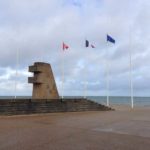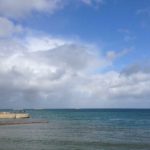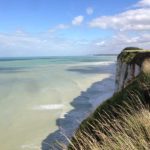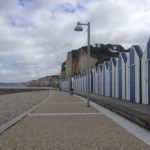D-Day was only two days ago, so it is about the right time to publish an itinerary that involves visiting some of the Canadian World War sites. In three days with a rental car, it makes a nice little road trip to visit all the landing sites in Normandy and the Canadian Vimy memorial.
The itinerary could only be “complete” by starting the journey in the UK like what soldiers would have done back then. First take the train from London to Portsmouth harbor. At Portsmouth, take the Brittany overnight Ferry ( http://www.brittany-ferries.co.uk/ferry-routes/ferries-france/portsmouth-caen ) to Caen. While it is not as glorious as hopping onto a landing craft and jumping into the surf zone like the soldiers of the 3rd Canadian Infantry Division at the near by Juno Beach, this is the closest route available for the modern comfort travelers to experience an overnight channel crossing.
Rent a car at Caen ( and load up a road bike ) and drive alone D514. Park the car at Sword Beach near Lion-Sur-Mel . Bike or walk to the Juno Beach Canadian Memorial. The previous landing zone is accessible by a broad walk along the beach. Even if you do not care about World War Two, it is still a glorious leisure walk to see the raging water of the English Channel. The official Juno Beach Center is actually farther west to the memorial. While it could be a site worth visiting for Canadians, others may find it marginally interesting.
- Juno Beach Center
- Juno Memorial
Continue on D514 to Omaha Beach, stop by Arromanches-les-Bains to appreciate the engineering wonder of the Mulberries harbor. The remnants of floating pierheads and sections are still visible. Stop for a quick bite and a coffee, and join the many tourists who come to see the spectacular view.
Omaha beach is not far way. Being there will make you appreciate the tough job the American landing force had to take on. The old battle site had since been reclaimed. A memorial and a trail system were built so that visitors could stroll around the site in relatively comfort. Take the trail from the memorial at the top all the way down to the beach. Look back and see for yourself the deadly climb the American soldiers had to make.
- Arromanches-les-Bains
- Omaha Beach
- American Omaha Memorial
Pointe du Hoc is also a site not to be missed. The German gun positions and bunkers are still intact. Here you can walk inside the bunker and experience the spectacular yet deadly views facing toward the channel through the observation post. If you are not yet tired of beaches and guns, Utah beach is not too far away. The museum there is great, but it is mainly geared towards the American audiences.
Before switching to World War One sites, make a nice drive along the northern shore of France. Instead of taking A29 straight to Amien, take the smaller roads along the shoreline. Make stops at the small cities and towns on the way. Stop by Le Havre to have lunch in the market and visit the casinos/hotels. Check out the picturesque views at Etretat, Yport and Fecamp that inspired a generation of impressionist artists such as Claude Monet. Don’t be afraid to make unexpected turns that may lead to small towns below the ridge, and most importantly, get off the car to explore. There is always the google map to get your out!
- fecamp
- Yport
After passing Dieppe, take A16 to Amiens. After a night of sleep, take D919 to Beaumont-Hamel where almost the entire Newfoundland Regiment was wiped out within 30 minutes in the Battle of the Somme. Take a second to image the carnage covering this tranquil landscape and appreciate the bravery of men that charged into sure death. The massive waste of lives in this small little piece of farm land is both sad and astonishing.
Continue on D919 and shift west just outside of Arras to Canadian National Vimy Memorial. Sitting on a strategic piece of high ground, Vimy Ridge was highly contested because it overlooks Douai Plain to the east. It was imperative for the allied force to capture the ridge to prevent German bombardment in 1917, and the mission was completed by the Canadians at a cost of over 10,000 casualties. After World War One, the French government gave the site to the Canadian government and a 27m tall cenotaph was subsequently completed in 1936, ironically just before the outbreak of World War Two. The solemn structure surely brings a moment of reflection to all the visitors. If you are interested in learning more about history, the museum on site houses an excellent exhibition on the Canadian Corp’s actions in the Great War.
- Yport
- Canadian National Vimy Memorial









